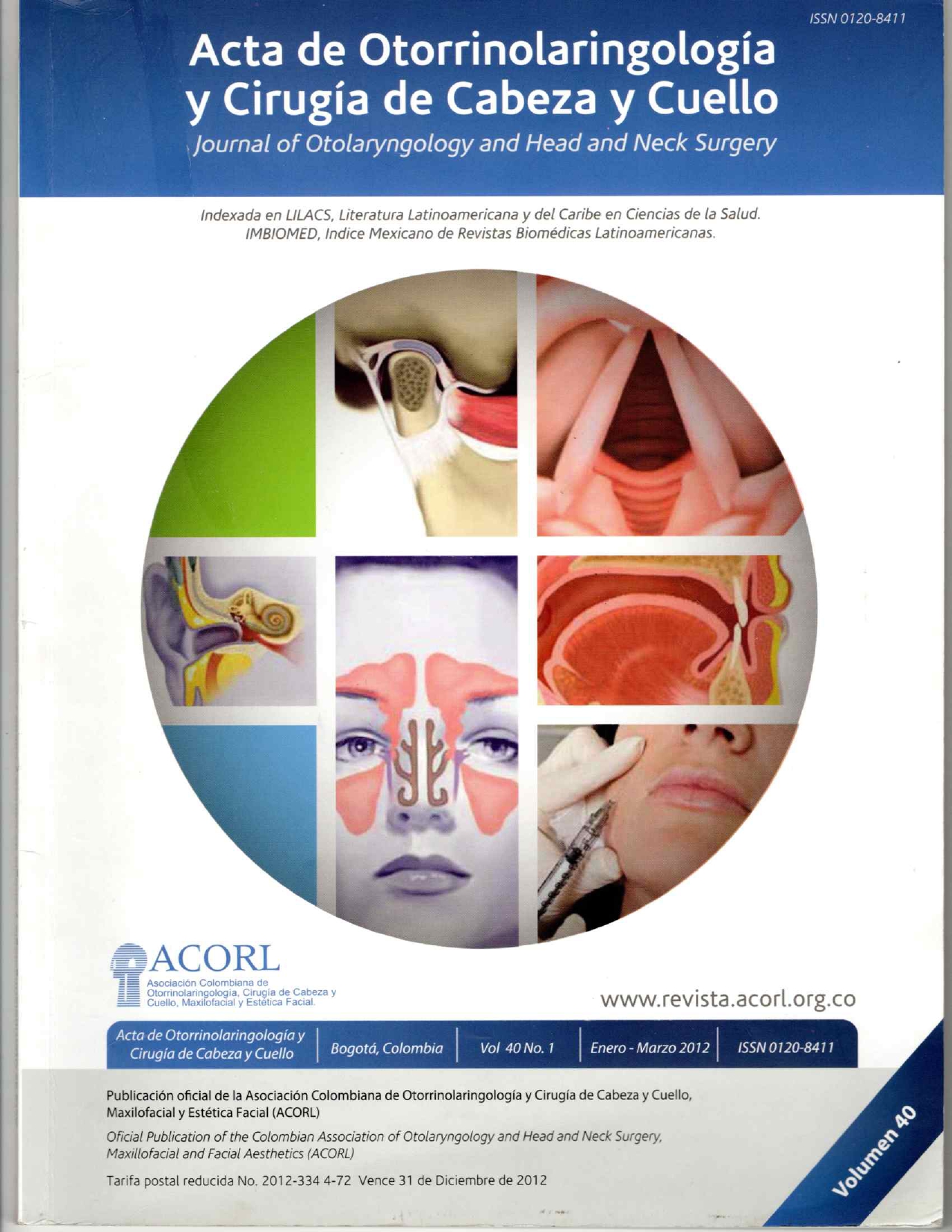Validación de una prueba diagnóstica: secuencia Fiesta de imágenes de resonancia nuclear magnética en schwannoma vestibular
Contenido principal del artículo
Resumen
Objetivo: Determinar la precisión diagnóstica de la resonancia nuclear magnética simple con secuencia Fiesta (RNM-Fiesta), comparada con la RNM contrastada con secuencia Fiesta en paralelo (RNM-Gd), para el diagnóstico de schwannoma vestibular (SV). Diseño: Estudio de precisión diagnóstica, fase-IIc. Métodos: Se estimó el desempeño de la RNM-Fiesta para el diagnóstico de SV, utilizando como prueba de oro la RNM-Gd. Se calcularon los indicadores diagnósticos en pacientes adultos con sospecha de SV, de un hospital de tercer nivel, entre agosto del 2010 y diciembre del 2011. Las imágenes fueron tomadas mediante un protocolo estandarizado y evaluadas de manera ciega e independiente por dos neurorradiólogos, usando asignación aleatoria de códigos para cada unidad de observación. La reproducibilidad de la evaluación se calculó con el índice KappaCohen de concordancia interevaluadores. Resultados: Se incluyeron 70 pacientes, de los cuales 21 presentaron SV y 49 sin SV. La sensibilidad de la RNM-Fiesta fue = 85,7% [IC 95% = 68,4%-100%], especificidad = 100% [IC 95% = 98,9%-100%], valor predictivo negativo = 94,2% [IC 95% = 86,9%-100%] y valor predictivo positivo = 100% [IC 95% = 97,2%- 100%]. La concordancia interevaluadores fue de 0,96 [IC 95% = 0,89-1,0] KappaCohen, p < 0,001. Conclusiones: La RNM-Fiesta es confiable como prueba diagnóstica inicial en pacientes con sospecha de SV.
Detalles del artículo
Sección

Esta obra está bajo una licencia internacional Creative Commons Atribución-CompartirIgual 4.0.
Este artículo es publicado por la Revista Acta de Otorrinolaringología & Cirugía de Cabeza y Cuello.
Este es un artículo de acceso abierto, distribuido bajo los términos de la LicenciaCreativeCommons Atribución-CompartirIgual 4.0 Internacional.( http://creativecommons.org/licenses/by-sa/4.0/), que permite el uso no comercial, distribución y reproducción en cualquier medio, siempre que la obra original sea debidamente citada.
eISSN: 2539-0856
ISSN: 0120-8411
Cómo citar
Referencias
National Institutes of Health. Acoustic neuroma. NIH Consensus Statement; 1991; 9: 1-24.
Jackler R. Acoustic neuroma. In Jackler RK, Brackmann D, editors. Neurotology. St Louis, MO: Mosby; 1994; 729-85.
Stangerup S-E, Tos M, Caye-Thomasen P, Tos T, Klokker M, Thomsen J. Increasing annual incidence of vestibular schwannoma and age at diagnosis. J Laryngol Otol, 2004; 118: 622-7.
Fortnum H, O’Neill C, Taylor R, Lenthall R, Nikolopoulos T, Lightfoot G, et al. The role of magnetic resonance imaging in the identification of suspected acoustic neuroma: a systematic review of clinical and cost effectiveness and natural history. Health Technol Assess, 2009; 13: 1-154.
Schmidt RJ, Sataloff RT, Newman J, Spiegel JR, Myers DL. The sensitivity of auditory brainstem response testing for the diagnosis of acoustic neuromas. Arch Otolaryngol Head Neck Surg, 2001; 127: 19-22.
Curtin H. Rule out eighth nerve tumour: contrast enhanced T1-weighted or high resolution T2-weighted MR? Am J Neuroradiol, 1997; 18: 1834-8.
Zealley IA, Cooper RC, Clifford KM, Campbell RS, Potterton AJ, Zammit-Maempel I, et al. MRI screening for acoustic neuroma: a comparison of fast spin echo and contrast enhanced imaging in 1233 patients [see comment]. Br J Radiol, 2000; 73: 242-7.
Hermans R, Van der Goten GA, De Foer B, Baert AL. MRI screening for acoustic neuroma without gadolinium: value of 3DFT-CISS sequence. Neuroradiology, 1997; 39: 593-8.
Ben Salem D. MRI screening of vestibular schwannomas without gadolinium: usefulness of the turbo gradient spin echo T2-weighted pulse sequence. J Neuroradiol, 2001; 28: 97-102.
Chavhan GB, Babyn PS, Jankharia BG, Cheng HL, Shroff MM. Steady-state MR imaging sequences: physics, classification, and clinical applications. Radiographics, 2008; 28: 1147-60.
Gluud C, Gluud LL. Evidence based diagnostics. BMJ, 2005; 330: 724-6.
Bossuyt PM, Reitsma JB, Bruns DE, et al. Towards complete and accurate reporting of studies of diagnostic accuracy: the STARD initiative. BMJ, 2003; 326: 41-4.
House JW, Bassim MK, Schwartz M. False-positive magnetic resonance imaging in the diagnosis of vestibular schwannoma. Otol Neurotol, 2008; 29: 1176-8.
Jackler RK, Parker DA. Radiographic differential diagnosis of petrous apex lesions. Am J Otol, 1992; 13: 561-74.
Hatipoğlu HG, Durakoğlugil T, Ciliz D, Yüksel E. Comparison of FSE T2W and 3D FIESTA sequences in the evaluation of posterior fossa cranial nerves with MR cisternography. Diagn Interv Radiol, 2007; 13: 56-60.
Mikami T, Minamida Y, Yamaki T, Koyanagi I, Nonaka T, Houkin K. Cranial nerve assessment in posterior fossa tumors with fast imaging employing steady-state acquisition (FIESTA). Neurosurg Rev, 2005; 28: 261-6.





